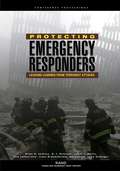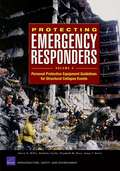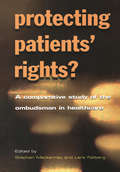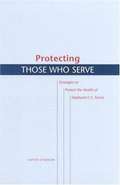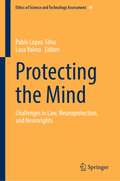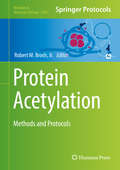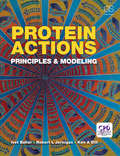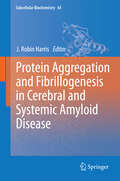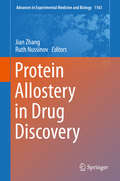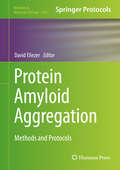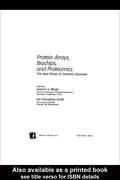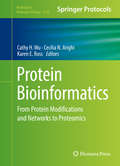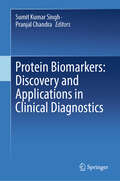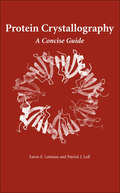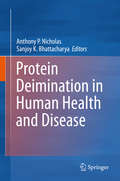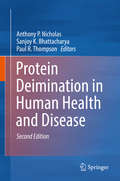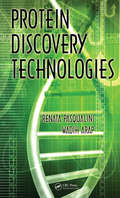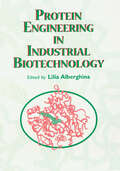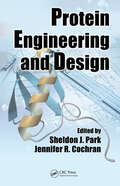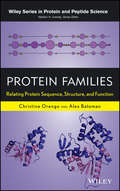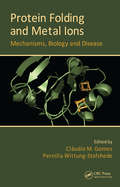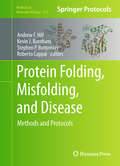- Table View
- List View
Protecting Emergency Responders
by Tom Latourrette Brian A. Jackson James T. Bartis Irene T. Brahmakulam D. J. PetersonIn December 2001, a conference held in New York City brought together individuals with firsthand knowledge of emergency responses to terrorist attacks to discuss ways to improve the health and safety of emergency workers who respond to large-scale disasters. The meeting considered the responses to the September 11, 2001 attacks at the World Trade Center and the Pentagon and the 1995 attack at the Alfred P. Murrah Federal Building in Oklahoma City, Oklahoma, as well as the emergency responses to the anthrax incidents that occurred through Autumn 2001. This book is intended to help managers and decisiomakers understand the unique working and safety environment associated with terrorist incidents, understand the equipment needs of emergency workers, and improve education and training programs and activities directed at the health and safety of emergency responders.
Protecting Emergency Responders, Volume 4
by Henry H. Willis James T. Bartis Elizabeth M. Sloss Nicholas G. CastleThis monograph serves as a technical source for National Institute for Occupational Safety and Health (NIOSH) incident commander guidelines for emergency response immediately following large structural collapse events. It gives guidelines for personal protective equipment (PPE), focusing on required modifications to responders' typical PPE ensembles because of the duration of response and the need to prevent exposures to likely hazards from pathogens, airborne dusts, and gaseous hazardous materials.
Protecting Our Forces
by Salem Fisseha Susan Thaul Stanley M. LemonInfectious diseases continue to pose a substantial threat to the operational capacity of military forces. Protecting Our Forces reviews the process by which the U.S. military acquires vaccines to protect its warfighters from natural infectious disease threats. The committee found that poorly aligned acquisition processes and an inadequate commitment of financial resources within the Department of Defense vaccine acquisition process - rather than uncleared scientific or technological hurdles - contribute to the unavailability of some vaccines that could protect military personnel and, implicitly, the welfare and security of the nation. Protecting Our Forces outlines ways in which DoD might strengthen its acquisition process and improve vaccine availability. Recommendations, which include combining all DoD vaccine acquisition responsibilities under a single DoD authority, cover four broad aspects of the acquisition process: (1) organization, authority, and responsibility; (2) program and budget; (3)manufacturing; (4) and the regulatory status of special-use vaccines.
Protecting Patients' Rights: A Comparative Study of the Ombudsman in Healthcare
by Peter TateA key text for doctors, this revised, expanded and updated edition now includes a section on understanding one's own attitudes and empathy, and greatly enhanced material on communication strategies and skills. The text is also suitable for candidates preparing for the MRCGP examination.
Protecting THOSE WHO SERVE: Strategies to Protect the Health of Deployed U.S. Forces
by Committee on Strategies to Protect the Health of Deployed U.S. ForcesSince the Gulf War ended in 1991, various constituencies, including a significant number of veterans, speculate that unidentified risk factors led to chronic, medically unexplained illnesses, and these constituencies challenge the depth of the military’s commitment to protect the health of deployed troops. Despite general concurrence in findings to support these claims, few changes have been made at the field level. The most important recommendations remain unimplemented, despite the compelling rationale for urgent action. Protecting Those Who Serve illuminates these recommendations and government-developed plans that remain inactive due to a lack of authority within the Department of Defense, while describing the dangers that may result from failure to protect our forces in the field.
Protecting the Mind: Challenges in Law, Neuroprotection, and Neurorights (Ethics of Science and Technology Assessment #49)
by Luca Valera Pablo López-SilvaThis book offers a comprehensive analysis of philosophical, social, ethical, and legal challenges arising as a consequences of current advances in neurosciences and neurotechnology. It starts by offering an overview of fundamental concepts such as mental privacy, personal autonomy, mental integrity, and responsibility, among others. In turn, it discusses the influence of possible misuses or uncontrolled uses of neurotechnology on those concepts, and, more in general, on human rights and equality. Then, it makes some original proposals to deal with the main ethical, legal, and social problems associated to the use of neurotechnology, both in medicine and in everyday life, suggesting possible policies to protect privacy, neural data, and intimacy. Crossing the borders between humanities, natural sciences, bio-medicine, and engineering, and taking into account geographical and cultural differences, this book offers a conceptual debate around policy and decision making concerning some of the key neuroethical challenges of our times. It offers a comprehensive guide to the most important issues of neurojustice and neuroprotection, together with a set of new paradigms to face some of the most urgent neuroethical problems of our times.
Protein Acetylation: Methods and Protocols (Methods in Molecular Biology #1983)
by Robert M. Brosh Jr.The book focuses on the regulation of protein function and biological activity by the post-translational modification known as acetylation. Chapters detail a wide range of topics in protein acetylation dealing with pathways relevant to cellular homeostasis, gene expression, and DNA metabolism. Written in the highly successful Methods in Molecular Biology series format, chapters include introductions to their respective topics, lists of the necessary materials and reagents, step-by-step, readily reproducible laboratory protocols, and tips on troubleshooting and avoiding known pitfalls.Authoritative and cutting-edge, Protein Acetylation: Methods and Protocols aims to be an extremely valuable resource to novices and experts alike whose research takes them in the direction of characterizing regulatory switches in protein acetylation events, and how they are manifested in significant ways in diverse mechanisms biological systems.
Protein Actions: Principles and Modeling
by Ken Dill Robert L. Jernigan Ivet BaharProtein Actions: Principles and Modeling is aimed at graduates, advanced undergraduates, and any professional who seeks an introduction to the biological, chemical, and physical properties of proteins. Broadly accessible to biophysicists and biochemists, it will be particularly useful to student and professional structural biologists and molecular biophysicists, bioinformaticians and computational biologists, biological chemists (particularly drug designers) and molecular bioengineers. The book begins by introducing the basic principles of protein structure and function. Some readers will be familiar with aspects of this, but the authors build up a more quantitative approach than their competitors. Emphasizing concepts and theory rather than experimental techniques, the book shows how proteins can be analyzed using the disciplines of elementary statistical mechanics, energetics, and kinetics. These chapters illuminate how proteins attain biologically active states and the properties of those states. The book ends with a synopsis the roles of computational biology and bioinformatics in protein science.
Protein Aggregation and Fibrillogenesis in Cerebral and Systemic Amyloid Disease (Subcellular Biochemistry #65)
by J. Robin HarrisThis volume of the Subcellular Biochemistry series is the result of the long-standing research interest of the editor in the molecular mechanism underlying Alzheimer's disease and other amyloid diseases, indicated also by the earlier book in the series (Volume 38), devoted to Alzheimer's disease. The broad coverage within the present amyloidogenesis book represents an attempt to collate current knowledge relating to the proteins and peptides involved in most of the known amyloid diseases, together with some amyloid/fibril-forming proteins and peptides that are not involved in diseases. Thus, the range of topics included is comprehensive and furthermore it was thought appropriate to include both basic science and clinical presentation of the subjects under discussion.
Protein Allostery in Drug Discovery (Advances in Experimental Medicine and Biology #1163)
by Ruth Nussinov Jian ZhangThe book focuses on protein allostery in drug discovery. Allosteric regulation, ʹthe second secret of lifeʹ, fine-tunes virtually most biological processes and controls physiological activities. Allostery can both cause human diseases and contribute to development of new therapeutics. Allosteric drugs exhibit unparalleled advantages compared to conventional orthosteric drugs, rendering the development of allosteric modulators as an appealing strategy to improve selectivity and pharmacodynamic properties in drug leads. The Series delineates the immense significance of protein allostery—as demonstrated by recent advances in the repertoires of the concept, its mechanistic mechanisms, and networks, characteristics of allosteric proteins, modulators, and sites, development of computational and experimental methods to predict allosteric sites, small-molecule allosteric modulators of protein kinases and G-protein coupled receptors, engineering allostery, and the underlying role of allostery in precise medicine. Comprehensive understanding of protein allostery is expected to guide the rational design of allosteric drugs for the treatment of human diseases. The book would be useful for scientists and students in the field of protein science and Pharmacology etc.
Protein Amyloid Aggregation
by David EliezerThis detailed volume focuses on methods for the characterization of aggregation processes that lead to the formation of amyloid fibrils and amyloid oligomers which feature in the etiology of a variety of human disorders collectively known as amyloidoses. The scope of the collection includes techniques for visualizing early steps on the amyloid formation pathway, methods for capturing and characterizing oligomeric, potentially toxic, intermediates, strategies for preparing and characterizing mature amyloid fibrils and approaches for understanding templating and transmission of amyloid aggregates. Written in the highly successful Methods in Molecular Biology series format, the chapters include introductions to their respective topics, lists of the necessary materials and reagents, step-by-step, readily reproducible laboratory protocols and tips on troubleshooting and avoiding known pitfalls. Authoritative and practical, Protein Amyloid Aggregation: Methods and Protocols serves as an ideal guide for biochemists and biophysicists with an interest in elucidating the mechanisms of protein amyloid formation, as well as chemists, pharmacologists and clinicians with an interest in leveraging an understanding of such mechanisms for the purpose of therapeutic development.
Protein Arrays, Biochips and Proteomics: The Next Phase of Genomic Discovery
by Joanna S. Albala Ion Humphery-SmithFrom disease marker identification to accelerated drug development, Protein Arrays, Biochips, and Proteomics offers a detailed overview of current and emerging trends in the field of array-based proteomics. This reference focuses on innovations in protein microarrays and biochips, mass spectrometry, high-throughput protein expression, protein-prote
Protein Bioinformatics (Methods in Molecular Biology #2836)
by Frédérique LisacekThis detailed volume explores techniques for protein bioinformatics research, including databases, software tools, and computational methods, in the context of protein science or proteomics and opening to other omics areas. Beginning with a section on proteogenomics, the book continues by covering posttranslational modifications, processing large-scale mass spectrometry data, protein structure and interactions, as well as protein feature inference. Written for the highly successful Methods in Molecular Biology series, chapters include the kind of detailed implementation advice to ensure efficacious results. Authoritative and practical, Protein Bioinformatics serves as an ideal guide for researchers in disciplines encompassing the biotechnological, pharmaceutical, biological, and medical sciences, as well as the computational and engineering sciences.
Protein Bioinformatics: From Protein Modifications and Networks to Proteomics (Methods in Molecular Biology #1558)
by Cathy H. Wu Cecilia N. Arighi Karen E. RossThis volume introduces bioinformatics research methods for proteins, with special focus on protein post-translational modifications (PTMs) and networks. This book is organized into four parts and covers the basic framework and major resources for analysis of protein sequence, structure, and function; approaches and resources for analysis of protein PTMs, protein-protein interactions (PPIs) and protein networks, including tools for PPI prediction and approaches for the construction of PPI and PTM networks; and bioinformatics approaches in proteomics, including computational methods for mass spectrometry-based proteomics and integrative analysis for alternative splice isoforms, for functional discovery. Written in the highly successful Methods in Molecular Biology series format, chapters include introductions to their respective topics, lists of the necessary materials and reagents, step-by-step, readily reproducible laboratory or computational protocols, and tips on troubleshooting and avoiding known pitfalls.Cutting-edge and thorough, Protein Bioinformatics: From Protein Modifications and Networks to Proteomics is a valuable resource for readers who wish to learn about state-of-the-art bioinformatics databases and tools, novel computational methods, and future trends in protein and proteomic data analysis in systems biology. This book is useful to researchers who work in the biotechnology and pharmaceutical industries, and in various academic departments, such as biological and medical sciences and computer sciences and engineering.
Protein Biomarkers: Discovery and Applications in Clinical Diagnostics
by Pranjal Chandra Sumit Kumar SinghThis book comprehensively reviews the fundamentals of biomarker discovery using mass-spectrometry-based proteomic and glycoproteomic methods. It also provides case studies of proteomic and glycoproteomic molecular signatures to illustrate the design and use of various mass spectrometry modes such as selected reaction monitoring (SRM), parallel reaction monitoring (PRM), and sequential window acquisition of all theoretical fragment ion spectra mass spectrometry (SWATH-MS). In turn, the book presents the challenges of the proteomic methods in biomarker discovery and approaches for overcoming these challenges by extending the performance by improving the sensitivity, throughput, and selectivity of the method. It also addresses the bottleneck of deriving useful biological interpretations from large multi-dimensional datasets emanating from these experiments by discussing data analysis pipelines and appropriate statistical analysis. Finally, a detailed discussion on the design, characterization, and application of protein/glycoprotein-based biosensors for clinical diagnostics is discussed. The book is intended to serve as a reliable resource for the students and researchers working in the area of biomarker discovery and validation using mass spectrometry-based methods and their subsequent applications for biosensor design.
Protein Crystallography: A Concise Guide
by Eaton E. Lattman Patrick J. LollThe proteome remains a mysterious realm. Researchers have determined the structures of only a small fraction of the proteins encoded by the human genome. Crystallography continues to be the primary method used to determine the structures of the remaining unknown proteins. This imaging technique uses the diffraction of X-rays to determine a protein’s three-dimensional molecular structure.Drawing on years of research and teaching experience, Eaton E. Lattman and Patrick J. Loll use clear examples and abundant illustrations to provide a concise and accessible primer on protein crystallography. Discussing the basics of diffraction, the behavior of two- and three-dimensional crystals, phase determination (including MIR and MAD phasing and molecular replacement), the Patterson function, and refinement, Lattman and Loll provide a complete overview of this important technique, illuminated by physical insights.The crisp writing style and simple illustrations will provide beginner crystallographers with a guide to the process of unraveling protein structure.
Protein Deimination in Human Health and Disease
by Anthony P. Nicholas Sanjoy K. BhattacharyaDeimination is a relatively new post-translational modification of proteins, whose recognition is ever-increasing. First linked to the pathology of rheumatoid arthritis (RA), deimination is a process by which selected positively charged arginine amino acids are converted to neutral citrulline amino acids by the peptidyl arginine deiminase (PAD) family of enzymes. Although the medical literature is rich with articles about the possible significance of deiminated proteins in RA, Protein Deimination in Human Health and Disease is the first publication to compile this knowledge and the growing amount of new information now known about the presence of deiminated proteins in the eye, skin, hair, gums, lung and nervous system, as well. As a result, this process has now been linked to numerous additional conditions besides RA, including cancer, glaucoma, Alzheimer's disease, Parkinson's disease, multiple sclerosis, spinal cord and peripheral nerve injury, Creutzfeldt-Jakob disease, among many others. Chronicling the earliest studies of deimination up to the present, this volume distills what is currently known about citrullination of proteins in the human body and is the first book of its kind on the topic.
Protein Deimination in Human Health and Disease
by Anthony P. Nicholas Sanjoy K. Bhattacharya Paul R. ThompsonPublished in 2014, Protein Deimination in Human Health and Disease was the first book on this novel post-translational modification, in which selected positively-charged arginine amino acids are converted to neutral citrulline amino acids by the peptidyl-arginine deiminase (PAD) family of enzymes. This area of research continues to expand rapidly, necessitating the need for this second edition. Chronicling the latest inflammatory, epigenetic, neurodegenerative, and carcinogenic processes, Protein Deimination in Human Health and Disease, Second Edition, updates the latest advances in deimination research, including new information on PAD enzyme structure and activity, and how PAD knock-out animals are being used to study known and newly-discovered links to various human diseases. The first edition outlined what was known about citrullinated proteins in normal tissues such as skin and hair, as well as in maladies such as rheumatoid arthritis (RA), multiple sclerosis (MS), Alzheimer's disease (AD), glaucoma, peripheral nerve injury, neonatal hypoxic brain damage, and breast cancer. This second edition addresses numerous additional disorders such as diabetes, asthma, traumatic brain injury, inflammatory bowel disease, lupus, bone disease, heart failure, fronto-temporal dementia, and prostate and colon cancer. It also provides updates on the deimination research covering the three seminal diseases first linked to this process (RA, MS and AD), and details how auto-antibodies against citrullinated proteins contribute to disease. In addition, new hypotheses on the possible pathologic mechanisms of citrullinated myelin basic protein and glial fibrillary acidic protein are also proposed. This second edition also outlines the latest developments in therapeutic strategies, including the use of new PAD antagonists and innovative techniques such as micro-vescicles and stem cells as possible mechanisms to treat these conditions.
Protein Discovery Technologies
by Renata Pasqualini Wadih ArapA True Insider's Guide to the Field - Then and Now Until now, there has not been a book that effectively addresses the historical basis of protein discovery. Featuring contributions from a distinguished international panel of experts, Protein Discovery Technologies elucidates the principles, techniques, strategies, and broad range of applications o
Protein Dysfunction in Human Genetic Disease
by Y. H. Edwards D. M. SwallowRecent years have seen rapid advances in our understanding of genetic diseases in terms of their molecular origins. The book focuses on DNA mutations which give rise to abnormalities of protein structure and function in genetic disease.
Protein Engineering For Industrial Biotechnology
by Lilia AlberghinaProtein engineering has proved to be one of the more fruitful technological approaches in biotechnology, being both very powerful and able to generate valuable intellectual property. This book aims to present examples in which the application of protein engineering has successfully solved problems arising in industrial biotechnology. There is a sec
Protein Engineering and Design
by Sheldon J. Park Jennifer R. CochranExperimental protein engineering and computational protein design are broad but complementary strategies for developing proteins with altered or novel structural properties and biological functions. By describing cutting-edge advances in both of these fields, Protein Engineering and Design aims to cultivate a synergistic approach to protein science
Protein Families
by Alex Bateman Vladimir Uversky Christine OrengoNew insights into the evolution and nature of proteinsExploring several distinct approaches, this book describes the methods for comparing protein sequences and protein structures in order to identify homologous relationships and classify proteins and protein domains into evolutionary families. Readers will discover the common features as well as the key philosophical differences underlying the major protein classification systems, including Pfam, Panther, SCOP, and CATH. Moreover, they'll discover how these systems can be used to understand the evolution of protein families as well as understand and predict the degree to which structural and functional information are shared between relatives in a protein family.Edited and authored by leading international experts, Protein Families offers new insights into protein families that are important to medical research as well as protein families that help us understand biological systems and key biological processes such as cell signaling and the immune response. The book is divided into three sections: Section I: Concepts Underlying Protein Family Classification reviews the major strategies for identifying homologous proteins and classifying them into families. Section II: In-Depth Reviews of Protein Families focuses on some fascinating super protein families for which we have substantial amounts of sequence, structural and functional data, making it possible to trace the emergence of functionally diverse relatives. Section III: Review of Protein Families in Important Biological Systems examines protein families associated with a particular biological theme, such as the cytoskeleton.All chapters are extensively illustrated, including depictions of evolutionary relationships. References at the end of each chapter guide readers to original research papers and reviews in the field.Covering protein family classification systems alongside detailed descriptions of select protein families, this book offers biochemists, molecular biologists, protein scientists, structural biologists, and bioinformaticians new insight into the evolution and nature of proteins.
Protein Folding and Metal Ions: Mechanisms, Biology and Disease
by Cláudio M. Gomes Pernilla Wittung-StafshedeThe role of metal ions in protein folding and structure is a critical topic to a range of scientists in numerous fields, particularly those working in structural biology and bioinorganic chemistry, those studying protein folding and disease, and those involved in the molecular and cellular aspects of metals in biological systems. Protein Folding an
Protein Folding, Misfolding, and Disease
by Andrew F. Hill Stephen P. Bottomley Roberto Cappai Kevin J. BarnhamProtein misfolding is a key feature of many disorders in humans, given that over twenty proteins are known to misfold and cause disease. In Protein Folding, Misfolding, and Disease: Methods and Protocols, experts in the field present a collection of current methods for studying the analysis of protein folding and misfolding, featuring strategies for expressing and refolding recombinant proteins which can then be utilized in subsequent experiments. This detailed volume also covers methods for analyzing the formation of amyloid, protocols for determining the size and structure of native and misfolded proteins, as well as specific examples of where misfolded proteins can be examined using state-of -the-art technologies. Written in the highly successful Methods in Molecular BiologyTM series format, chapters contain introductions to their respective topics, lists of the necessary materials and reagents, step-by-step, readily reproducible laboratory protocols, and key tips on troubleshooting and avoiding known pitfalls. Up to date and authoritative, Protein Folding, Misfolding, and Disease: Methods and Protocols offers researchers the tools necessary to move ahead in this vital field.
